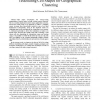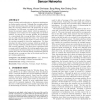618 search results - page 10 / 124 » Coverage with Connectivity in Wireless Sensor Networks |
IEEECIT
2010
IEEE
13 years 6 months ago
2010
IEEE
This paper investigates the energy-saving organization of sensor nodes in large wireless sensor networks. Due to a random deployment used in many application scenarios, much more n...
IJSNET
2006
13 years 7 months ago
2006
: In this paper, we present a two-tiered scheduling approach for effective energy conservation in wireless sensor networks. The effectiveness of this mechanism relies on dynamicall...
IJSNET
2008
13 years 7 months ago
2008
Abstract: This paper addresses the target coverage problem in wireless sensor networks. Communication and sensing consume energy, therefore efficient power management can extend ne...
TWC
2008
13 years 7 months ago
2008
Target tracking and localization are important applications in wireless sensor networks. Although the coverage problem for target detection has been intensively studied, few consi...
EWSN
2006
Springer
14 years 7 months ago
2006
Springer
Abstract. Coverage is a very important issue in wireless sensor networks. Current literature defines a point to be covered if it is within the sensing radius of at least one sensor...


